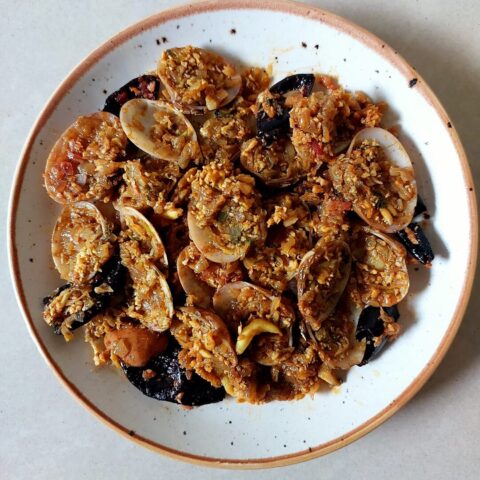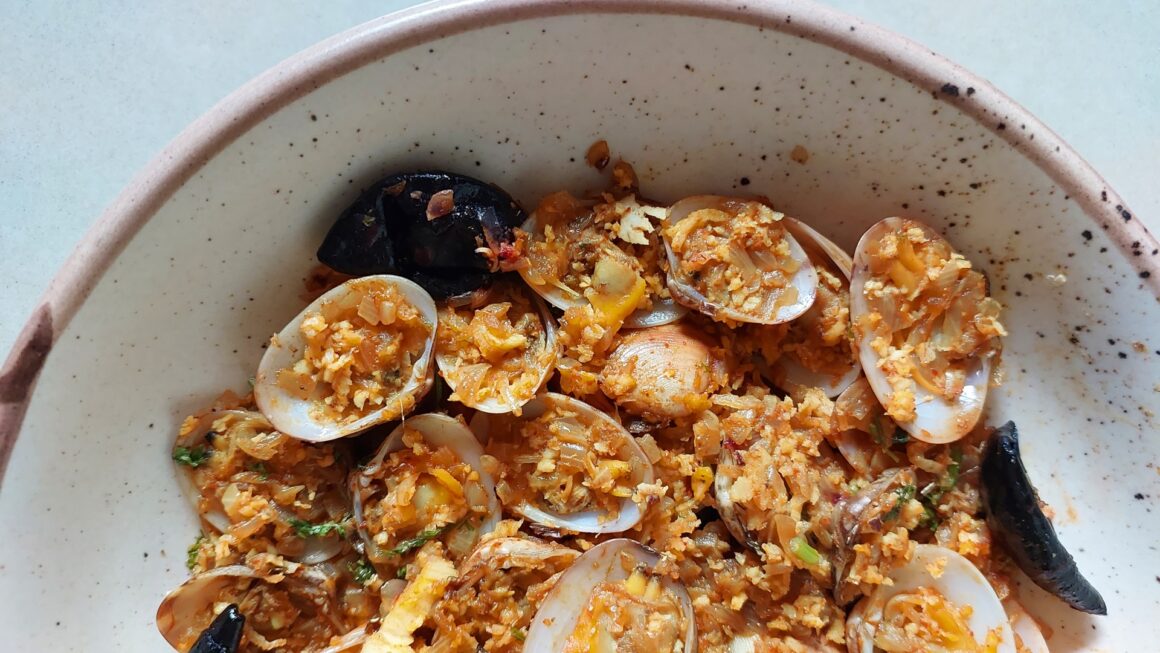“I am on a Seafood Diet. When I see food, I just must eat it!” This once-upon-a-time popular meme certainly applied to me since I was a toddler, thanks to my Gowd Saraswat Brahmin (GSB) DNA.
My First Exposure to Teesrya
Until the age of 5, I was exposed to a variety of seafood. But it was when I turned 8 that I saw my Aai (Marathi for Mother) seated on a Vili (a traditional vegetable/fish knife/cutter with a low wooden bench which has a curved steel blade with a serrated edge attached at one end). She was busy separating something that looked like shellfish. Intrigued, I sat beside her. On the table, there were two plates. One plate had half-opened shells filled with round and tiny whitish-yellowish meat, while the other plate held empty shells. Aai told me this was Teesrya. I imitated my parents in how to eat them: separating the meat from the shell and licking off the juices. That was my introduction to Teesrya. From that day on, it became my favorite seafood, and even now, as a 25-year-old adult, licking off the shell’s juices is an absolute delight.
How I Found the Recipe of Authentic Goan Saraswat Style Teesrya Chi Koshimbeer – An Interesting Story
Mumbai is a Mecca for seafood lovers, with an abundance of seafood restaurants. As an Assal GSB (literally meaning True GSB!), fish delicacies were regularly prepared in our home. But when I wanted to explore new flavors incorporating seafood, I couldn’t resist visiting popular seafood restaurants in the city. During one of these visits as a teenager, I came across a renowned seafood restaurant, my personal favorite, where I found the dish “Teesrya Chi Koshimbeer” on the menu. The dish sounded unusual, and being my favorite, Teesrya piqued my curiosity. When it arrived at the table, it looked incredibly tempting, with the shells and meat coated in a semi-dry, ground green coconut-spice masala. It tasted delicious. Some time later, as a teenager, I tried the same “Malvani style Teesrya Chi Koshimbeer” at another popular seafood restaurant. Surprisingly, the latter restaurant listed it under the main course section of the menu. However, the look, preparation style, and, most importantly, the taste felt as if the same chef worked in both restaurants—no change at all.
Just a month ago, I visited the former popular restaurant again, this time accompanied only by Aai. I ordered the Teesrya Chi Koshimbeer. As it arrived at our table, I took a moment to observe it before digging in. Suddenly, I felt the urge to interview my mother and ask her the most important question: “Do we have Teesrya Chi Koshimbeer in our Saraswat Style?” She nodded affirmatively. I then asked her how it was made, and she shared with me the ingredients, nuances, and the process of making it. After the detailed conversation with my mother at the seafood restaurant table, we savored the restaurant’s style of Teesrya Chi Koshimbeer, accompanied by Neer Dosa. We enjoyed the moment, but deep down in my heart, I was tired of the same style of Teesrya Chi Koshimbeer being served by every other seafood restaurant in Mumbai. I eagerly looked forward to making the real and rare Saraswat Style Teesrya Chi Koshimbeer, the recipe for which my mother had told me just by recollecting her observation as a teenager how my now 82 year Grand Aunt hailing from Pedne (in Goa) used to make it.
Why Teesrya Chi Koshimbeer Is Made the Way It Should Be Made – The Art (Nuance) and Science (Grand Aunt’s Passed Down Culinary Wisdom) of Making This Gem of a Dish
Koshimbeer is a Marathi word that stands for a cool and refreshing vegetable salad consumed by Maharashtrians during the summer. However, GSBs, who consider seafood as “vegetables from the sea,” happily consume koshimbeer only if it includes fish. For this reason, Goan Saraswat women came up with the perfect summer dish years ago – Teesrya chi Koshimbeer.
When I interviewed my Aai, she not only gave me the recipe for Koshimbeer but also shared the passed-down culinary wisdom behind my Grand Aunt’s Teesrya chi Koshimbeer, which was enlightening for me. Firstly, she explained that since Koshimbeer is a summer special dish, it must include cooling ingredients. Secondly, the preparation should be effortless.
The Goan Saraswat Style Teesrya chi Koshimbeer is primarily cooked with finely chopped onions. Onions are a vital ingredient, taken in double the quantity of the Teesrya, to give the Koshimbeer the perfect dry but moist texture. The softened onions naturally release their own water, which is complemented by crushed ginger and grated garlic. Ginger and garlic are essential in seafood dishes to neutralize the seafood’s natural smell. Since hot spices should be minimized in summer, Teesrya chi Koshimbeer is seasoned only with a pinch of turmeric powder and a dash of red chili powder for zest. As the Teesryas sizzle and crackle in the pan, they are coated with freshly sprinkled grated coconut. However, the major flavor of this Koshimbeer comes from coriander and cumin powder. Once the clams are coated in these four spices and tossed with freshly grated coconut, kokum is added to give a tangy layer of flavor to this delicacy. Before removing from the flame, the finished Teesrya chi Koshimbeer is garnished with freshly chopped coriander leaves and can be enjoyed with Chapati or Taandalaachi Bhaakri.
Cooked within 15 minutes, without any grinding and without the typical restaurant-style green-hued masala, this rare and authentic Teesrya chi Koshimbeer from my Goan Saraswat Grand-Aunt’s treasure trove is a delicacy that can give restaurants a run for their money!

GOAN SARASWAT STYLE TEESRYA CHI KOSHIMBEER
A dry salad of Clams cooked in coconut and tossed in spices
Ingredients
- 2 – 2.5 cups opened up clams with meat transferred to one side of the shell. (See Note below on how to clean and open up clams)
- Oil – 3 – 4 tbsp
- Asafetida – ¼ tsp
- Onions – 3 large size, finely chopped
- Ginger – 1 tbsp, grated
- Garlic cloves – 8, crushed
- Turmeric powder – ½ tsp
- Red chili powder – 2.5 tsp
- Freshly grated coconut – ½ cup
- Coriander powder – 2 tsp
- Cumin powder – 1.5 tsp
- Salt – 2 tsp
- Kokum Petals – 6, (Or ¼th cup tamarind pulp if Kokum is unavailable)
- Coriander leaves – ¼th cup, freshly chopped
Process:
- Take a wide and deep bottom pan. Add oil. Once the oil is nicely heated add asafetida and finely chopped onion followed by grated ginger and crushed garlic. Give the ingredients one stir. Keep the flame entirely on low, cover the cooking pot with a lid. Allow the onions to soften and the raw smell of ginger-garlic to go away by cooking them for 5-7 mins.
- Add turmeric and red chili powders. Stir and close the lid. Cook for 2 mins on low flame. Drop inside now the Clams. Stir the clams once so that they are nicely coated with the onions and the Spice powders. Keep the lid and on medium low flame allow the clams to cook for 5 mins.
- Switch the flame entirely to low, sprinkle freshly grated coconut, add coriander and cumin powder, and season the Koshimbeer with salt. Stir the Koshimbeer; cook covered on low flame for 2 mins.
- Add Kokum (or tamarind pulp), sprinkle coriander leaves. Give the Koshimbeer a final cooking for 2 mins, covered on medium-low flame. Switch off the flame once the Koshimbeer is cooked. Allow the dish to rest for at least 15 mins for all the flavors and the Kokum’s sourness to gel in the clams.
- Serve Teesrya chi Koshimbeer hot, accompanied with Chapati or Rice Flour Bhaakri.
Note on Cleaning and Opening of Clams:
When buying Clams, always look for the shells that are small in size. The meat of these Clams is the tastiest. Big sized shell Clams only have more meat, but no taste.
After Clams are brought home, wash them nicely under water 4-5 times. Once the dust/sand is all removed, keep the clams in water.
- Opening up Clams in Traditional Method i.e. By using Vili (Traditional cutter)
Move the damp clam shell against the blade of the Vili (The vegetable cutter).Twist one side of the shell. The clams will open in half. Transfer the clam meat on one side of the shell. Retain the shells with transferred clam meat and discard the empty shells.
- Opening up Clams by Steam cooking Method
Put the washed Clams in a pan. Add some water (a little, just a tad lesser than the required to submerge all the clams) and heat it for about 5-6 mins, covered. The clams will gradually open up. Put off the gas once they open up and let them be till they cool. Split open the clams by twisting the top shell.
Watch this recipe here – Teesrya Chi Koshimbeer

Shivani Kulkarni is an old soul trapped in a 25-year-young body, born and raised in a Gowd Saraswat Brahmin family in Mumbai. Formerly a stylist in the glamorous world of Home and Product Styling, Shivani made a bold decision to leave her full-time job and focus on her passion project: Authentic Swaad, a food blog she had started during the lockdown while planning her styling projects.
Growing up, Shivani was well acquainted with the diverse flavors of Goan-Karwari-Konkan Saraswat cuisine. She realized the importance of preserving the precious pearls of culinary wisdom passed down by her mother and the intricate nuances behind cooking these delectable dishes. With her blog, she aims to share the treasured recipes from her family and community, documenting traditional and lesser-known Gowd Saraswat dishes.
Through her blog, Shivani not only showcases the recipes but also joyfully narrates the food memories associated with them. Join her on a journey of exploring the authentic flavors and rich heritage of Gowd Saraswat Community, as she strives to preserve and celebrate the culinary traditions of her community.
Translations and detailed descriptions are provided to give a better understanding of the story to people from different cultural backgrounds across the globe.

